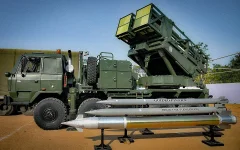- Views: 3K
- Replies: 12
India's primary defence research agency, the Defence Research and Development Organisation (DRDO), has taken a significant step towards enhancing the nation's infantry firepower by revealing the initial prototype of a new 6.8mm assault rifle.
Developed by the Pune-based Armament Research and Development Establishment (ARDE), a key DRDO laboratory, this weapon represents a potential indigenous solution for the Indian Army's long-standing quest for a modern small arms system.
Showcased in early 2025, the rifle, chambered for the 6.8x43mm cartridge, incorporates modern design elements such as a 30-round polymer magazine reinforced with metal and an adjustable telescopic stock. This development places it among the latest advancements in India's homegrown family of assault rifles.
Experts suggest its caliber offers a unique balance, providing stopping power comparable to the 7.62x39mm round (used in AK-series rifles) while being lighter than weapons using the 7.62x51mm ammunition, potentially making it a strong candidate for the Army's next standard-issue rifle.
This 6.8x43mm prototype stems from ARDE's focus on creating a versatile, next-generation firearm specifically designed for the Indian Army's operational needs. It differs from DRDO's 2024 launch, the 7.62x51mm 'Ugram' rifle, by seeking a middle ground that optimizes lethality, user manageability, and adaptability across different combat environments.
While expected to weigh less than typical 7.62x51mm rifles (often exceeding 4 kg), it aims to retain substantial impact force. This approach mirrors international developments, like the U.S. Army's adoption of a 6.8mm round for its Next Generation Squad Weapon program, seeking better range and effectiveness against modern body armour compared to the older 5.56mm NATO standard.
Key design aspects highlighted in the prototype include its durable polymer magazine with metal inserts and the telescopic stock, which allows for better handling in varied conditions, from close-quarters urban combat to operations in mountainous or jungle terrains.
Although specific performance details like effective range and firing rate are currently undisclosed, the rifle is expected to use a gas-operated system, likely building on ARDE's experience with the previous INSAS and Ugram rifles, aiming for operational reliability.
The 6.8x43mm cartridge itself is noted as a special-purpose round designed to offer improved ballistic performance over the 5.56mm without the significant weight and recoil associated with larger 7.62mm rounds.
The emergence of this prototype is timely, as the Indian Army continues efforts to replace its INSAS rifles, which have been in service since the 1990s. Recent procurements, including 72,000 SIG Sauer SIG716 rifles (7.62x51mm) acquired through emergency procedures in 2020, and a joint venture with Russia to produce AK-203 rifles (7.62x39mm) that has faced delays, indicate a move towards more powerful calibers for specific operational needs.
The new 6.8x43mm rifle, however, could offer a balanced alternative, potentially being more portable than the SIG716 while delivering greater lethality than standard 5.56mm weapons, making it suitable against protected targets. Observers on social media have termed the 6.8mm a potential "sweet spot" caliber.
This development might also signify a revival of interest in the 6.8x43mm caliber previously explored in ARDE's Multi-Calibre Individual Weapon System (MCIWS) project from the last decade, which was eventually shelved.
Incorporating features like a polymer magazine and telescopic stock points towards an emphasis on user comfort and adaptability, likely including provisions like Picatinny rails for mounting sights, scopes, and other accessories common in modern warfare.
The question arises whether this indigenous rifle could become the standard firearm for the Indian Army. Its characteristics appear aligned with the Army's requirements for lightweight, dependable weapons offering enhanced stopping power, particularly crucial in high-altitude areas along the Line of Actual Control (LAC) and the Line of Control (LoC).
The 6.8mm prototype could potentially offer advantages over the heavier SIG716 in sustained combat scenarios and presents a more viable indigenous production option compared to the AK-203, whose manufacturing plan has been impacted by geopolitical factors like the Russia-Ukraine conflict. This aligns strongly with the government's 'Aatmanirbhar Bharat' (self-reliant India) initiative in defence production.
However, the path ahead involves significant challenges. The prototype must successfully pass rigorous testing phases, including internal evaluations by ARDE and extensive field trials conducted by the Army under extreme environmental conditions, from the cold of Ladakh to the heat of Rajasthan.
Consistent accuracy, reliability, and overall durability will be key performance indicators. Furthermore, it faces competition from the already inducted SIG716, used by frontline troops, and the potential revival of the AK-203 project.
Introducing a new, non-standard 6.8x43mm caliber also necessitates establishing a dedicated ammunition manufacturing and supply chain, presenting a significant logistical undertaking for the armed forces.





